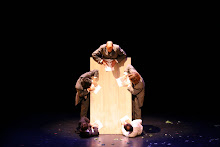Excerpt of ICKL Proceedings 1999
LABAN, LEEDER... MEMORY OF MOVEMENT
by
Teresa Monsegur
You have to give the best of yourself without trying to be perfect
Sigurd Leeder
The last class
I remember that morning very clearly; it was one of the last classes with Leeder. The
enthusiasm we then shared is always with me; it’s what drives me, the ever-existing game,even when things get difficult.
That morning, together with the other members of the course, we were doing the exercise that Leeder had suggested to me: to make a bridge. In the previous session he had talked to us about the idea of a bridge: as a link between two places, as a construction from two opposed landscapes, as spaces that join from two different shores... But also as a link between different ideas and ways of performing, or as a place suspended in space between two different realities...which allow us to know others and ourselves, to join, share, compete.
Bridges that are destroyed and built eternally in the winds of history...
That morning I was building a bridge with two groups of dancers placed on opposite sides of the room. Through levers and wheels and elements that pile up, join, screw; bit by bit, the dancers projected structures that fitted in with the ones that, in a symmetrical way, were being created at the other side of the stage.
And Leeder was there, present, with a presence that stimulated and respected the discoveries that were made, sharing the enthusiasm generously. For this reason the room was more like a big kitchen where we were all sharing the excitement of making a cake.
Introduction
I feel, humbly and deeply, that I am the retainer and transmitter of a tradition that understands art as an exercise of humanity and freedom.
I’m not going to talk about technical problems, go deeply into notation systems or develop any rigorous historical studies. But I want to talk about some experiences, which were deeply artistic, and took place, many years ago, in a very poor and beautiful remote country; and of how these experiences continued to spread in spite of storms, and of the strange ways in which they have been fruitful. I want to talk about the period in which Sigmund Leeder was.
Excerpt of ICKL Proceedings 1999
the director of the “Escuela de Danzas”, which was part of the College of Musical Arts and Science of the University of Chile.
History
All through the twenties, Laban was engrossed in the process of teaching and developing his theories about movement. Sigurd Leeder collaborated directly with him from a self-taught perspective. And that school and that system, became the link between Kurt Jooss and Leeder, who would train and forge their artistic relationship there; the former as choreographer and the latter as educator.
This was, broadly speaking, the beginning of what would later, with the Diaspora that
Hitler’s rise to power brought, spread all around the world.
The Jooss Ballet arrived to Chile in 1941, moving the Chilean artistic world by revealing the great possibilities of human movement as a theatrical language, due to it’s unity of conception, the deepness of it’s contents, the rigorous execution, musicality and thematic versatility. It became obvious then, as there were already plans to create a National Ballet, why the Institute of Musical Extension of the University of Chile signed up three of the members of the Jooss Ballet, Ernst Uthoff, Lola Botka and Rudolf Pesht, to create a dance school dependant of the University. This school would later become the origin of the Chilean National Ballet.
At first, the school and the Ballet were practically the same entity and it was possible to combine the tasks of both institutions. However, after some time, the growing national and international success, the enormous amount of applications to study dance in Chile and the difficulty of combining the professional work of the dancers and choreographers with the teaching, made it necessary to separate the school from the Ballet. This brought a change of the syllabus to adapt it to the new requirements that emerged and to make the educational work professional. It became obvious then that it would be essential to have someone directing the school full time. For this reason, Sigmund Leeder was chosen in 1959 to direct
the Escuela de Danzas.
Leeder in Chile
In 1928, Leeder had presented in Germany, his Kinetography, which came directly from a study Laban had made on movement notation. This difficult task was a manifestation of his spirit of invention, his love for perfection and his patience. He continued working on the process of developing the art of writing during all his life, trying to make it precise, clear and systematic. So, when he arrived in Chile in 1959, he brought with him a solid theory that immediately became part of the Curricular Design of the school. To my knowledge, this was the first time that movement notation based on Laban was taught in an Official School, at least in the Hispanic world.
Leeder developed his own methods of Dance Technique, Coreuthics, Eukinethics and
Kinetography. The pillar on which he based his educational action, was the idea of not training dancers but of educating human beings to become fully so, therefore, to become artists: as Schiller said “Only in play is man fully himself”...
Dance, as an educational discipline and artistic expression, is and will become increasingly important and, in time, will gain recognition in other educational systems. ”
As for specific training, it says:
“ The dancer should not be trained inside the conception of a specific stylistic. He should be allowed to develop his technical and expressive skills as widely as possible. The training must turn him into an instrument that is sensitive to the richness that today’s theatrical expression demands. ”
“The choreographer’s training must contain the analytical knowledge of the whole dance complex and a clear comprehension of the emotional contents of movement, and of its dynamic and formal sense. ”
“The training of teachers directed to amateurs is based on the fact that dance has always played an essential role in the social activities of every culture, it was never confined exclusively to the stage. ”t has always acted as a harmonising power, and this is due to the fact that its performance affects the human being in its physical, emotional and intellectual integrity.”
For all these reasons, Leeder saw the necessity of justifying the notation of movement as a subject and a specialisation. About this matter he says:
“It’s necessary to have a notation system that can register any type of movement and is capable of giving us a precise image of its characteristics in time, space and energy."...
Leeder adapted Laban’s system by structuring a training methodology in which all the aspects of movement would be worked on, to try and educate dance professionals to have a wide artistic, critical and analytical spirit. Curious and sensitive people, who are able to think, analyse and compare and are not limited by anything, not even a style of dance.
Leeder the teacher
Each significant apprenticeship makes us question everything we had learnt before when the act of teaching becomes an important part of life. As Ortega y Gasset said: “A lesson is a highly dramatic incident for the one who gives it and for those who receive it. When this doesn’t happen it’s not a lesson but something else ñmaybe a crime- because it’s an hour lost and life is limited by time, so losing part of it is like killing life, like practising white murder.”...
In the pedagogy lessons he used to say to me: -Each lesson I give is dedicated specially to one student, in each lesson I try to watch one person and adapt the movement so that it helps them specifically in their own dance. This was the way in which Leeder was present in his classes and it’s also the sign of the teacher’s greatness...
He once told me that he had learnt never to judge talent in others because of an incident he had witnessed: Laban had a student in his school whom he used to lose his patience with.
She was a bit fat and not flexible at all. She couldn’t raise her leg more than 20 or 30 degrees and she did this with great effort: she had to put her leg on a chair and... Hop! She lifted it with both hands. So Laban was constantly expelling her from his classes: -Hey you, no talent, out! But she would come back again and again. After a few years the woman disappeared and they never saw her again. They thought the woman had gone back to her home to do her “housework”. One day, though, while on tour, they went into a small theatre where a small dance festival was taking place and they watched and were very touched by a woman dancing, who drew triangles in space with her body and left them there, set up in space. This woman was, no other than Mary Wigman. From this experience they learnt or tried to learn that another person’s talent should never be questioned. This was very important, not only as a personal way of seeing things, but also as and educational concept.
http://www.ickl.org/conf99_proceedings/monsegur.pdf
Subscribe to:
Post Comments (Atom)





1 comment:
You write very well.
Post a Comment